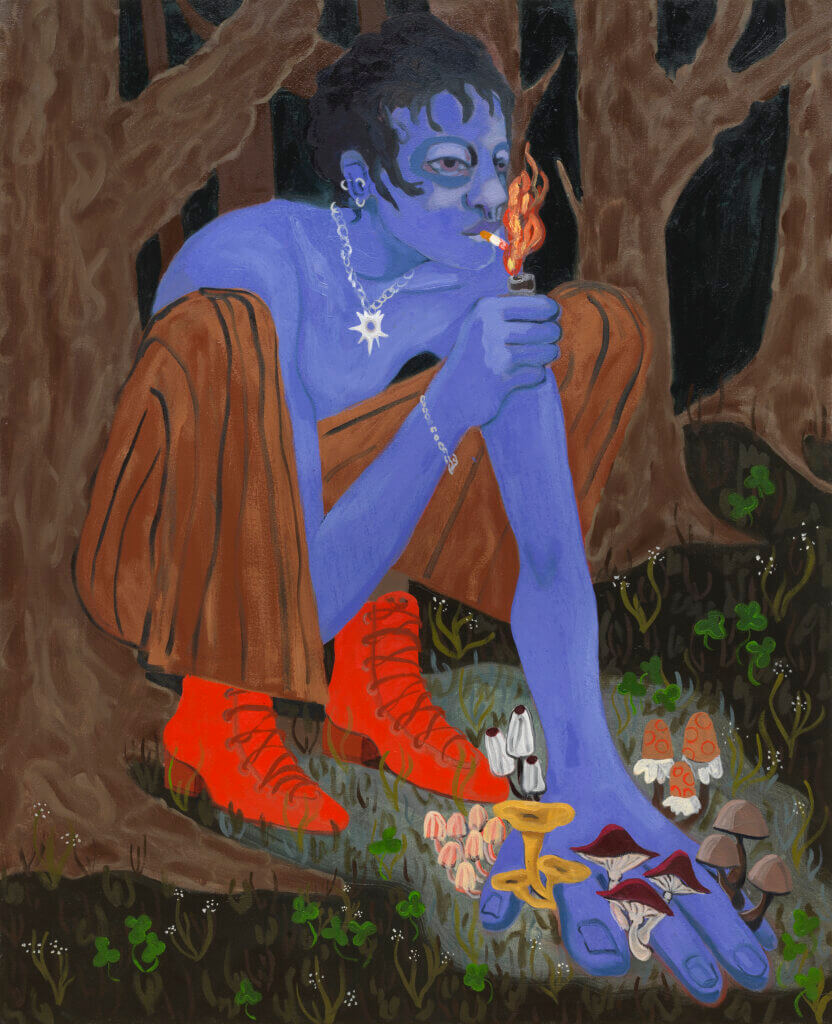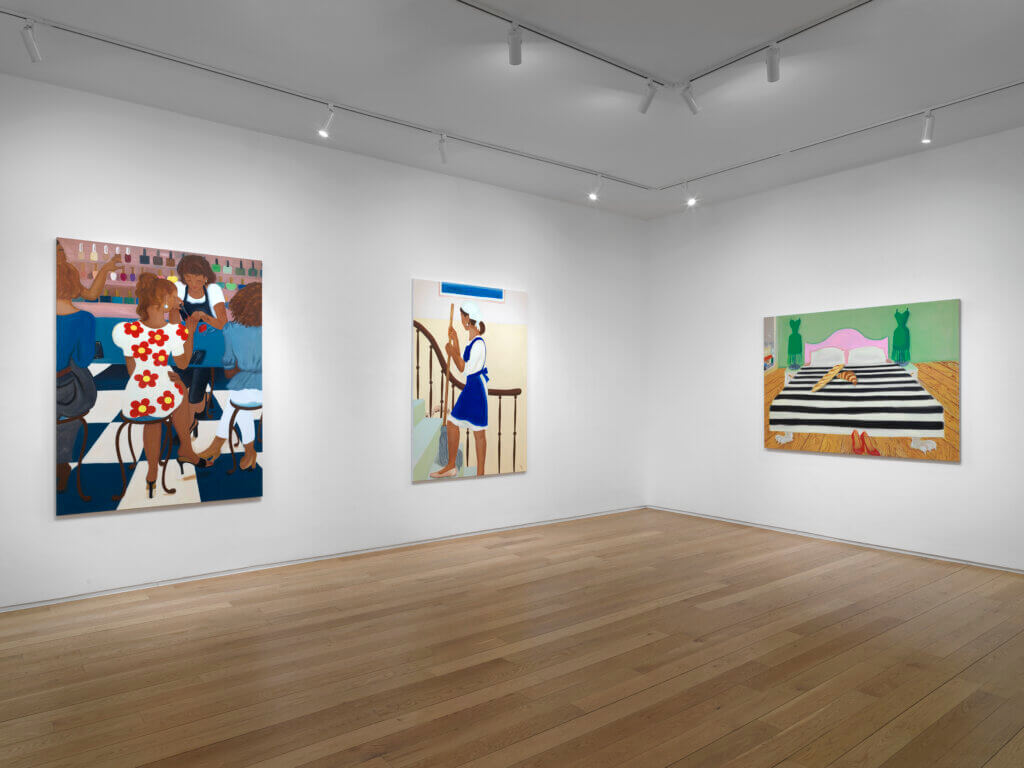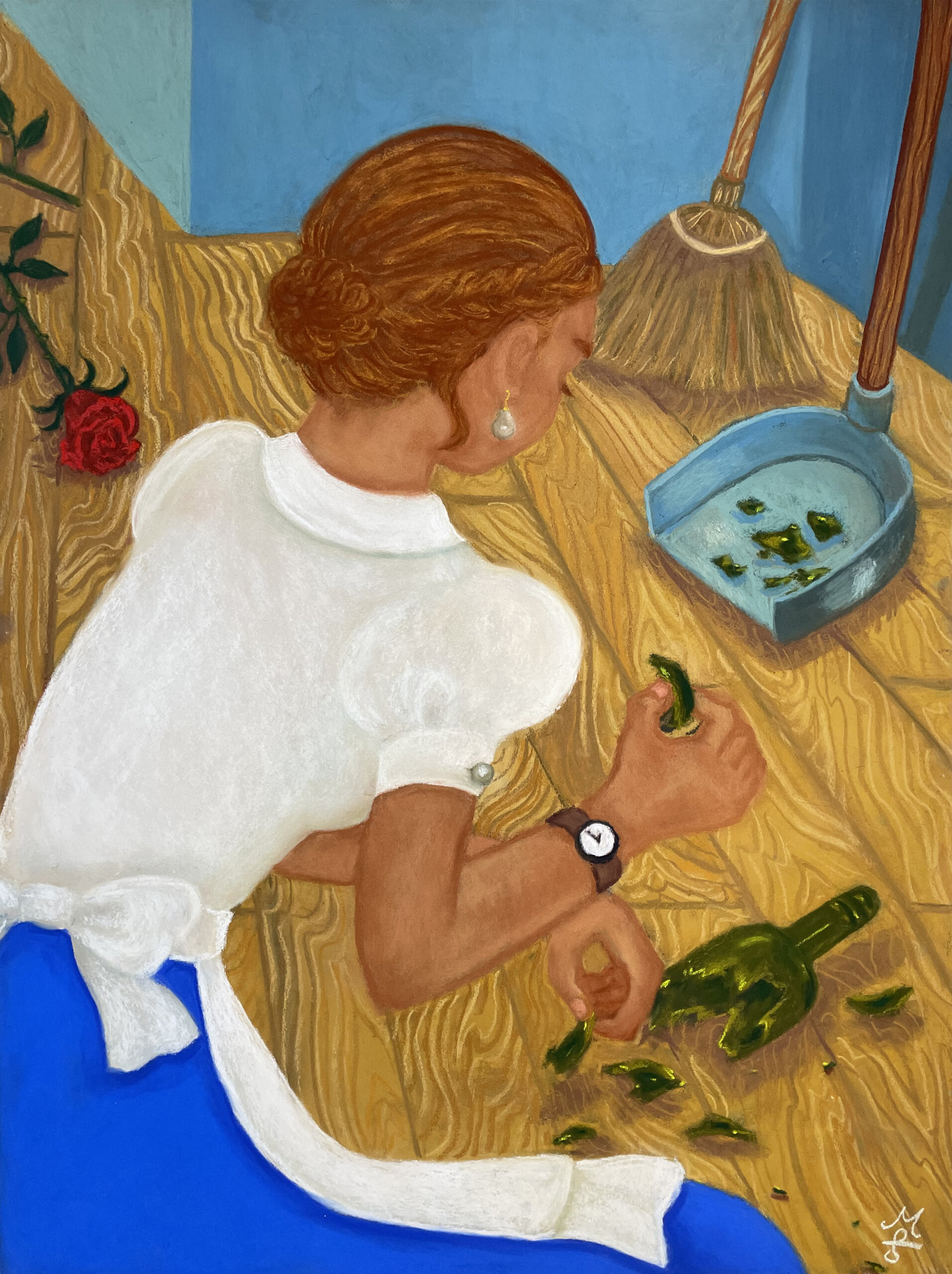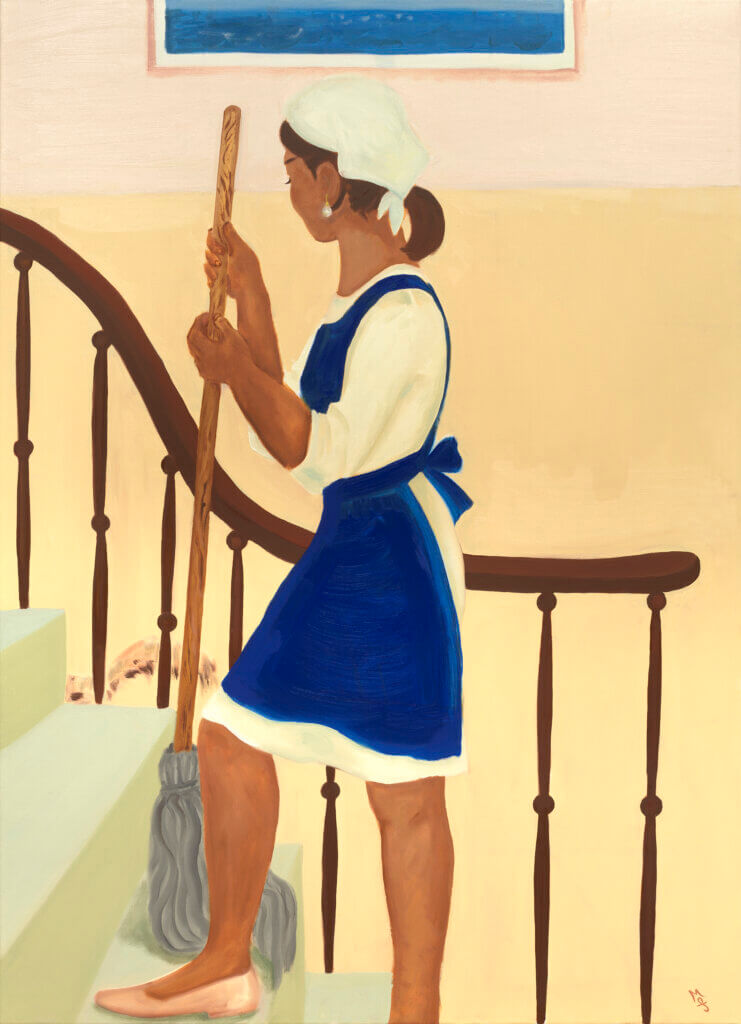
Katja Farin, Maria Farrar, Esme Hodsoll, Alyina Zaidi (March 1-April 5, 2023) at Alexander Berggruen, New York.
On the occasion of our exhibition Katja Farin, Maria Farrar, Esme Hodsoll, Alyina Zaidi (March 1-April 5, 2023), we spoke with the artists about their work.

Katja Farin, Maria Farrar, Esme Hodsoll, Alyina Zaidi (March 1-April 5, 2023) at Alexander Berggruen, New York.
Los Angeles-based Katja Farin depicts ambiguous spaces, often punctuated by patterns in warping logic, where the rules of repetition meet curving planes. Farin’s treatment of their figures’ eyes, multiplying body parts, and lyrically-colored skin tones outwardly projects the figures’ internal processing of their traumas and identities as they progress towards self actualization.

Katja Farin
Mushroom Aura, 2023
oil on canvas
42 x 34 in. (106.7 x 86.4 cm.)
Q: Occasionally, the figures in your work appear to be fluid and mutate with multiplied eyes, heads, and limbs. What may this represent for you in terms of your interpretations of social environments and internal processing?
A: Yeah, so basically the morphing of bodies and doubling and transmogrifying shapes allude to difference in body and perception. Through my experience as a trans person, the body and mind can be disconnected with the reality of the self. I try to investigate the difference between the internal self and the self perceived by others.

Katja Farin
Am I the problem?, 2023
oil on canvas
45 x 35 in. (114.3 x 88.9 cm.)
Q: The colors you paint are often highly saturated and unreal. How do you determine which colors to use?
Yeah, I like to experiment with unreal colors to explore the nature of the subconscious—an unreal confusing space. I usually am changing the colors of the work as I paint. It’s always morphing and changing based on the emotional content of the painting.
Q: At the core of your work is an inquiry into how our surroundings affect, in your words, “our inner self, the relationships we make, the ways we cope and the feelings we have”. How do the spaces you inhabit affect your internal world? What is your studio like?
My studio is really a sanctuary and has become a place to research emotions and interpersonal relationships. I host dinners, friends come over to work and collaborate. But also, the cities I live in and travel to greatly affect the setting of my paintings. I’ll pick up things as I travel that get included in the works.

Katja Farin, Maria Farrar, Esme Hodsoll, Alyina Zaidi (March 1-April 5, 2023) at Alexander Berggruen, New York.
Maria Farrar captures everyday moments marked by colors and techniques inspired by the cultural confluence in her life between her native Philippines, upbringing in Japan, and her current home in London. Farrar embraces the unknown by imbuing her compositions with an occasionally fragile, otherworldly physics.

Maria Farrar
Broken glass, 2023
pastel on paper, framed
31 1/2 x 23 5/8 in. (80 x 60 cm.)
Courtesy of the Artist and Ota Fine Arts.
Q: Select female figures in your work are often depicted with the same pearl earring. What is the significance of this earring?
Connection to the sea, being lost in-between places, beauty in imperfection.

Maria Farrar
Housekeeper and dog, 2023
oil on linen
70 3/4 x 51 1/4 in. (180 x 130 cm.)
Courtesy of the Artist and Ota Fine Arts.
Q: In speaking about this body of work that was inspired by your recent trip to your mother’s village in the Philippines, Santa Barbara, you mentioned that you’ve begun embracing transparent forms to honor the parts of your work and life that seem to be “not quite right” or perhaps seem to “need fixing.” How has allowing space for these elements in your painting affected the narrative quality of your work? What power does this give those objects that you allow to remain translucent?
Being half Filipino and half English, but only having lived in the Philippines until the age two, the presence of the culture within me feels transparent, as if it could disappear any moment, or suddenly appearing when I don’t expect it. The forms share that feeling.
Q: Two of your paintings in this show – Housekeeper and dog and Nail salon – honor unseen feminine labor through depicting nail technicians and a housekeeper. What does your portrayal of these figures represent for you?
I want them to be seen. I want to push for a society where every kind of work is cherished, rewarded, and can be done with pride.

Esme Hodsoll in the studio, Paris, France, 2023.
Photo: Daniel Beres
Courtesy the Artist and PATERSON ZEVI.
Paris-based Esme Hodsoll approaches her work with the delicate attention of a classical painter concerned with the contemporary moment. Working entirely from life, Hodsoll’s studio and domestic spaces act as sites for contemplation, as is often reflected in the aura of her painted objects.

Esme Hodsoll
Palm (by Night), 2021
etching on Zercale paper, framed
plate: 11 3/4 x 9 1/8 in. (30 x 23 cm.)
print: 14 3/4 x 11 3/8 in. (37.4 x 28.9 cm.)
frame: 17 1/8 x 13 3/4 in. (43.5 x 35 cm.)
Edition of 20
Courtesy the Artist and PATERSON ZEVI.
Q: What role does devotion and commitment play in your practice?
I’m devoted to my intuition. To paint, one must be in touch with oneself on an instinctive level.
Q: How do you determine what subjects and compositions to focus on? What attracted you to depicting Palm (by Night), for instance?
By staying connected to myself, subjects simply appear. I can usually tell which to pursue or abandon, and which to suspend if the timing isn’t right. There’s an aspect of mystery in the selection, which I don’t tend to question.

Esme Hodsoll
Man Bathing (At Night), 2022-2023
oil on copper, framed
9 7/8 x 7 7/8 in. (25 x 20 cm.)
Courtesy the Artist and PATERSON ZEVI.
Q: Between the water, hair, and cotton towel in Man Bathing (At Night); the wrinkled plastic bag in Lemons; and the lines of the leaves and shadows in Palm (by Night), texture seems to be an important feature in your work. What appealed to you about these textures in particular?
When one is obsessed by something/someone, everything about it/them seems interesting or worthy. I couldn’t imagine being attracted to the appearance of someone/thing, but not how they/it sounded for instance. The same way I love a bath throughout, from the progressive sound of the water filling the tub, to the look and feel of the dryness of the towel. For me, appeal is absolute, and painting is the realization of the resulting sensations.

Katja Farin, Maria Farrar, Esme Hodsoll, Alyina Zaidi (March 1-April 5, 2023) at Alexander Berggruen, New York.
London-based artist from New Delhi and Srinagar, Alyina Zaidi builds, in her own words, “magical landscapes” where rituals occur and symbolism abounds. Inspired by the long-lasting bright colors of Persian and South Asian miniature paintings and the gardens in Kashmir and Delhi, Zaidi paints interwoven patterns and forms, charting a selective web-like map populated by animals and characters she calls her “spirits”.
Q: Rhubarb rhapsody features a fishing hook with a worm on it in the center top register – a rare instance of human interference in your work. What role do humans play in your work? How do you determine when their presence is instrumental in the narrative?
Who says there is any human interference in Rhubarb rhapsody? Humans haven’t yet played a role in my worlds but perhaps they will sometime soon…

Alyina Zaidi
Rhubarb rhapsody, 2023
acrylic on canvas
32 x 32 in. (81.3 x 81.3 cm.)
Q: Your paintings sometimes form nonlinear topographies, depicted from multiple perspectives at once. Could you please elaborate on your process to arrive at these distinct compositions?
I wish I had one answer for you but I don’t. Each painting has a different approach. Sometimes the size or shape dictates how I handle the composition and my multiple perspectives. Sometimes I decide on a color combination at the start and then play around with the color relationships which then leads to interesting landscapes within landscapes. Other times I pick a movement and take it from there.

Alyina Zaidi
Clingen Cling On, 2023
acrylic on canvas
32 x 32 in. (81.3 x 81.3 cm.)
Q: The color relationships in your work are strikingly well-balanced between bold contrasting colors and subtle earthy or fleshy tones. How do you determine which color relationships to explore?
This purely depends on my frame of mind. I am very fickle with my colors.
Katja Farin, Maria Farrar, Esme Hodsoll, Alyina Zaidi (March 1-April 5, 2023) at Alexander Berggruen, New York.
Artwork and Installation Photos: Dario Lasagni